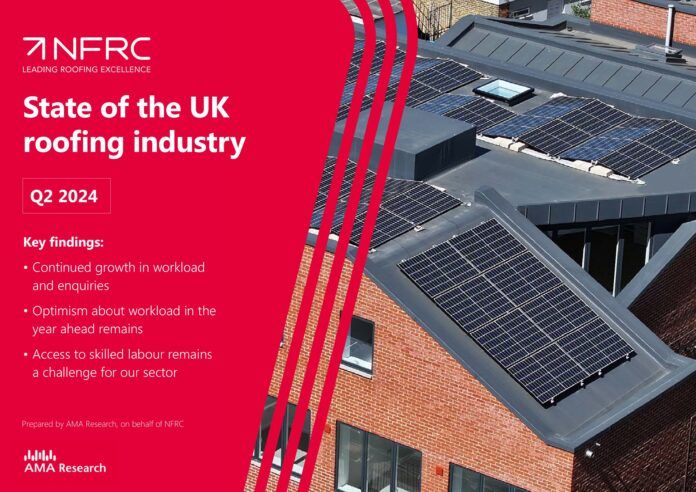The NFRC’s latest State of the UK Roofing Industry survey, covering Q2 of 2024, has reported continued positive trends in terms of workloads and enquiries for roofing contractors, as well as signs of reduced material cost pressures. However, it also highlights UK regions and areas of the industry where challenges remain.
Work and enquiries continue a positive trend
The survey showed a total balance figure of 15% of respondents reporting increased workloads (38% reporting an increase minus the 23% reporting a decline), which indicates that growth continues. This is down from the overall balance figure of 25 in Q1 but still offers positive news for the sector.
With the exception of new residential, all new build and RMI sectors have positive balance figures, with commercial new build performing the best (27% net figure) followed by domestic RMI (22%) and commercial RMI (21%).
Although the new build residential sector is still on balance reporting a decrease in work with a figure of -8, more respondents are seeing an increase in work compared with Q1 of the year – 25% versus 17%.
However, workloads were found to vary significantly across the UK, with the North-West and Midlands reporting the highest positive net figures of 20% each, while Scotland and Wales had strongly negative figures of -43 and -34 respectively. Members operating UK wide had the highest proportion reporting an increase in workload with 56%, and only 13% saying they have seen a fall in work.
>>Be sure to attend the panel at the RCI Show featuring Tanya Cooper of the NFRC on 24th October.
Meanwhile, the survey reported a net increase in enquiries of 10% and the South West and North West returned strongly positive balance figures of 37% and 30%, respectively. However, London & Southern Counties, Wales, and Yorkshire & North East all had negative net figures (-5, -67 and -37%, respectively).
Looking ahead, 48% of respondents said they expect workloads to increase in the coming year, with only 15% expecting a decline. Notably, many of those operating in the new build residential sector are expecting improved conditions in the next year, with a net figure of 31% forecasting an increase in work.
Recruitment challenges remain
There has been little change in terms of the proportion of respondents who have found it difficult to recruit in Q2 2024. In both Q1 and Q2, 53% reported that recruitment was more difficult than in the previous quarter. However, in Q2, a smaller proportion of respondents reported recruitment to be easier than in Q1 (3% vs. 9% easier, respectively). On balance, 50% found it more difficult to recruit in Q2 compared with 44% in Q1.
Material costs and availability improve
Continuing the trend from the previous quarter, the availability of materials improved again with a balance of 6% reporting that sourcing materials was easier in the three months to the end of June.
Furthermore, a balance of 48% of respondents reported higher prices in the second quarter, compared to 55% in the first quarter, suggesting that price inflation is beginning to lessen.
Late payment persists
The State of the UK Roofing Industry survey found that 90% of respondents have payment terms of 45 days or less with customers. However, just 71% reported receiving payment within that timeframe. Furthermore, although it is only a small proportion (3%), there are those in the sector that are having to wait more than 90 days for payment.
Commenting on the State of the UK Roofing Industry survey, James Talman, CEO of the NFRC, said: “The results provide promising news for our industry, continuing the generally positive trends we saw at the start the year. The key indicators suggest that the roofing sector, and the construction industry at large, is heading in the right direction. However, it is also clear that members in some regions and areas of the industry are still facing challenges.
“We are currently settling into a new era of government in the UK and it remains to be seen how this will affect the work of our members. The government has set ambitious new targets for housebuilding and will introduce policies with the aim of achieving those targets. As these efforts take effect, future editions of this survey may show further signs of growth and optimism.”




